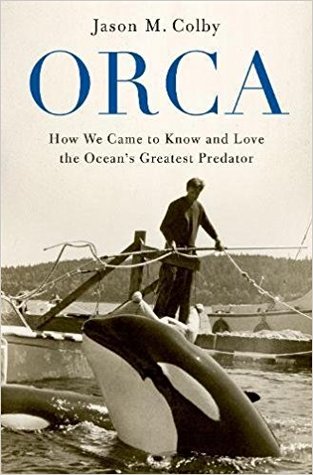
Orca: How We Came To Know And Love The Ocean’s Greatest Predator – Jason M. Colby – Oxford University Press – Published 1 June 2018
♥♥♥♥♥
Synopsis
Since the release of the documentary Blackfish in 2013, millions around the world have focused on the plight of the orca, the most profitable and controversial display animal in history. Yet, until now, no historical account has explained how we came to care about killer whales in the first place.
Drawing on interviews, official records, private archives, and his own family history, Jason M. Colby tells the exhilarating and often heartbreaking story of how people came to love the ocean’s greatest predator. Historically reviled as dangerous pests, killer whales were dying by the hundreds, even thousands, by the 1950s–the victims of whalers, fishermen, and even the US military. In the Pacific Northwest, fishermen shot them, scientists harpooned them, and the Canadian government mounted a machine gun to eliminate them. But that all changed in 1965, when Seattle entrepreneur Ted Griffin became the first person to swim and perform with a captive killer whale. The show proved wildly popular, and he began capturing and selling others, including Sea World’s first Shamu.
Over the following decade, live display transformed views of Orcinus orca. The public embraced killer whales as charismatic and friendly, while scientists enjoyed their first access to live orcas. In the Pacific Northwest, these captive encounters reshaped regional values and helped drive environmental activism, including Greenpeace’s anti-whaling campaigns. Yet even as Northwesterners taught the world to love whales, they came to oppose their captivity and to fight for the freedom of a marine predator that had become a regional icon.
Orca is the definitive history of how the feared and despised “killer” became the beloved “orca”–and what that has meant for our relationship with the ocean and its creatures.
My thoughts
Orca: How We Came To Know and Love the Ocean’s Greatest Predator is an incredible book. It seemingly borders the divide between research tome and story, drawing upon well-written narrative to convey a thorough recall of the history of the interactions between humans and orca.
Like many, I have watched the documentary Blackfish. Like many others, I have been long enthralled with the awesome power and grace of the Orcinus Orca, starting from my childhood love of whales and dolphins. I have seen students complete assignments on the now-popular aforementioned documentary, but wondered what parts of the story might have been missing, what other truths there are to be revealed about the history of humans and orcas. It was with great pleasure that I discovered Orca. Not only could I satisfy my own curiosity, but I could add to our library’s collection and our students’ research a source that provides a thorough investigation of this history, and one that considers all sides of the story.
Orca is thorough. It starts with an introduction, citing the author’s own curiosity and history with the topic, and referencing his sources of information. Chapter one then takes readers back in time, all the way to Rome 50 CE, where Pliny records his encounter with an orca who had become trapped in the Roman harbour of Ostia. As the Romans were apt to do, the orca was fought and violently killed. Pliny’s records of the event and the creature reflected the tone for human interactions and observations for thousands of years to come. In the following chapters, Orca outlines the beliefs and attitudes held towards killer whales and how this governed people’s actions. Through the personal anecdotes of key players, both human and orca, key settings, and key social and political climates, Orca demonstrates the changes to these believes and how these changes were sparked.
I greatly enjoyed reading Orca. For such an information-rich text, it was surprisingly easy to read. It fact, I simply could not put it down, grabbing any spare moment to devour it once more. I read it from cover to cover, and I feel that this is the best way to enjoy this book, as well as get the most from the unfolding stories and information. The timeline of the text flows in a looping pattern, following the stories of individuals, taking the time to detour to explanations and other key related events before circling back around again. In this way the events and characters of the history come to life.
I enjoyed reading this book from the perspective of an interested amateur, someone who is passionate about these wondrous creatures, as well as from the perspective of acquisitions for our library. I can see the great value of the book for researchers. The research and evidence gathered for this text is immense and it is all clearly referenced, providing an extensive source of support for the provided information and links to further reading. However, I can also see the value for the general reader. Easily accessible, the importance of this story and the balance it gives to the presented ‘sides’ or arguments is so necessary, especially given past events and the renewed interest in captivity and protection of killer whales. And while the history might differ slightly, the resulting lessons hold true for any animal-human interactions.
The author’s own personal history has resulted in a text that could not have been produced without the connections and sources it provided. This arguably gives the author a particular bias, but he is upfront about this connection and it allows him to provide a unique perspective. The author’s argument that the way in which people view killer whales today and their desire to protect them sprung from the very thing they now protest – the capture and showing of orcas.
Orca does not include in its scope many of the events shown in the documentary Blackfish. Instead it clearly outlines the history of human-orca interactions, focusing on the general beliefs held and the individuals and their actions that shaped this history. Orca provides a unique and personalised relaying of an incredibly vast amount of facts, dates, and testimonies, and as such it is an invaluable source when considering the history between humans and orcas.
The publishers provided an advanced readers copy of this book for reviewing purposes. All opinions are my own.
More information
Category: Non-fiction
Themes: Orca, Killer Whales, Marine life, Conservation, Environment, Human-animal relationships, North American history.
Advisory: References to animal cruelty, death and injury.
Published: 1 June 2018 by Oxford University Press.
Format: Hardcover, ebook. 408 pages.
ISBN: 9780190673093


Leave a Reply